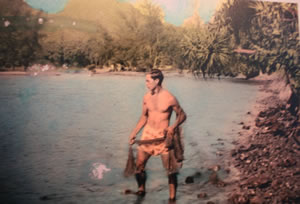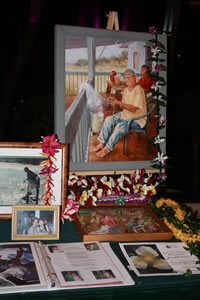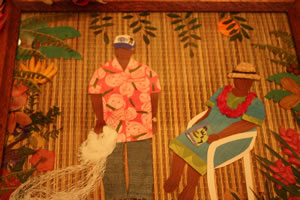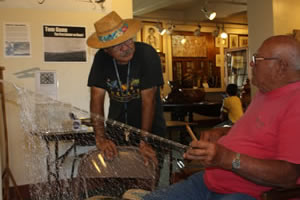Uncle Charlie And The Net
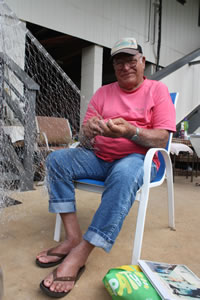
No, not the Internet the fish net. It's been Uncle Charlie Pereira's companion since he was a young boy growing up on Kaua'i, and now he is perpetuating this Hawaiian tradition by teaching younger generations
Uncle Charlie Pereira perpetuates and teaches the ancient Hawaiian fishing style – how to make a net, then how to throw and retrieve it
There are many lessons to be learned from Uncle Charlie Pereira, master of holei ‘upena (throw-net fishing) and Kaua’i treasure-troveat-large: Tread softly, take only what you need, and whenever you’ve got a good catch, always share the feast.
“If I ever caught a big bunch a fish, I never just give someone one fish, I give ’em the whole thing,” Pereira says.
Known around the island for two things “sewing net” and adoring Loke, his wife of 53 years, who passed away in 2009 Pereira is an icon representing a simpler time on Kaua’i.
The 82-year-old, who has several songs recorded about him, including Uncle Charlie by Chuck Meek, Charlie’s Song by Larry Rivera and Tutu Kale O Moloa’a by Chucky Boy Chock due out later this year, Pereira also was named a Garden Island Living Treasure by Kaua’i Museum.
Having grown up near the Menehune Fish Pond in Niumalu, fish were a stone’s throw from his home. His mother Gloria, born and raised in Lihu’e near the old sugar mill, was the daughter of Portuguese immigrants from San Miguel. His father Philomen, a fisherman from Medeira, Portugal, came to Kaua’i when he was 4 years old.
It was at the young age of 7 that Pereira got a taste for catching fish at Nawiliwili on the breakwater.
In those days, he would fish in the mornings before dawn and evenings after sundown, because “that’s when the fish couldn’t see us yet,” he says. He and his father would trek out to the shoreline or the reef and wait.
Taking care to delicately pull in the catch also was crucial. “If you’re throwing on sand, you pull it in,” he says. “If it’s rocks, you pick up every piece of the net.”
It wasn’t long before Pereira got a taste for the other attributes throw-net fishing offers: peace, solitude and, of course, a little bit of glory.
Around age 12 he asked his father if he could take the net and go out on his own.
“I figured I was big enough to throw the net myself,” he says. “I only caught one fish. But I was so happy that I caught one fish. I came home and said, ‘Well, Mom, I can fish, too.'”
Soon after that he sewed his first net a crab net. From then on he was, so to say, hooked.
“I always went fishing, sometimes by myself, also I went with Dad and kept him company,” he says. “The thing with Dad was, when we went out we’d stay an hour or two hours longer, and you don’t ask how long you’re going to stay out. And that was good, because you completely relax anyway.”Though his family was large he has two sisters (one is his twin) and two brothers he was the only one who really had an interest in learning the trade.
The family lived in Niumalu until shortly after the 1946 tsunami, which caused huge waves throughout Hawai’i.
“I will never forget it,” he says. “My father used to always say, ‘When water is backing up like that, you go find a high spot.’ So it was way, way out. My brother was the baby, and we all walked up that hill and stayed up there for a while. When we came back, we had crabs and fish in our backyard. Mom told our neighbors they could have the crabs and fish, and told us we were moving.” The family picked up and moved to Lihu’e, right across from Wilcox hospital.
As an adolescent, Pereira not only helped put fish on the table, but also began earning a paycheck. He started working in the plantation fields at Grove Farm, harvesting sugar, at the age of 12.“I made $1.25 a day at Grove Farm plantation,” he says. “My daddy made $50 a week and I made $50 a month.”
Though he didn’t finish high school, Pereira earned his GED after he was drafted into the military at age 21. Sent to Schofield Barracks during the Korean War, it was an assignment that would change his life for the better, as it was on O’ahu that he found his wife.
“Loke was driving the shuttle bus. We met at the terminal one day. We were sitting together and I asked her to buy me an ice cream, and she did,” he says. Also from a Kaua’i family of fisherman, Loke’s father was Andrew Lovell, a konohiki for much of the Eastside, including Pila’a, and her sister was Charlie’s twin sister’s classmate. The two eloped and wedded in a chapel at Schofield Barracks.
“We got married on O’ahu and came home and told our parents we were married,” he says.
The couple traveled during his military career and spent six years in Germany and some time in Texas. They went on to have daughters Cheryle and Gloria, five grandchildren and five great-grandchildren.After his military career, Pereira worked in construction for four years, then worked at Coco Palms for 24 years, where he got his start as a groundskeeper, and watched the hotel go through hurricanes Iwa and ‘Iniki.
Now retired, he’s got more time for the skill that has made him an icon on the Garden Isle. Pereira packs up his needle, spacer and line to set up shop and sew as onlookers watch Saturdays at Kaua’i Museum. And he is a staple of the Thursday poi pounding at Waipa, which he attends weekly with his grandson Blake.
Pereira makes the rounds to visit longtime friend and The Pineapple Store owner Chucky Boy Chock.
“I’ve known uncle Charlie for more than 25 years. In fact, after his wife passed on, he has been visiting me every Friday to wala’au,” Chock says. “Besides his fun stories, he brings me poi from Waipa, which I totally enjoy, and of course the making of his ‘upena fish net. When he comes to my shop to sew, the visitors are always in awe, and of course it helps that Uncle loves to wala’au.”
Whether he’s making a net of 20 feet, which takes him about three weeks (it used to take about two), or making his own weights, which he does by melting down recycled material on his little Coleman stove, Pereira says he’s happy to keep the tradition alive.Kidding that the nets he sews are “not for little boys, but men,” Pereira does take to heart the old adage of teaching a man to fish so he can eat for a lifetime. So much so, in fact, that despite the going rate of $300 for a handmade net, Pereira has accepted far less even cookies.
“The first question I ask is how much can you give me, because not everyone can afford it with how much life costs these days,” he says.
As for how he plans to spending his time in upcoming weeks, it will entail “more sewing than fishing,” he says. “I have a long list of people waiting.”


